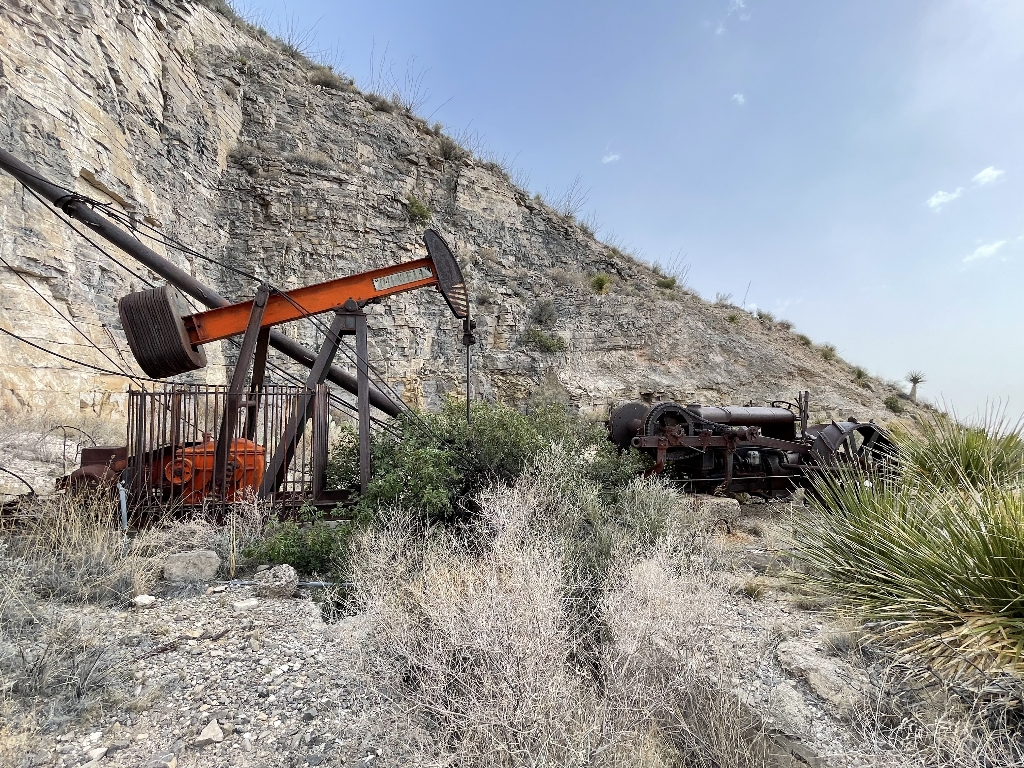
The Pure Well site, located to the west of Bartlett Peak is closed to the public until the completion of the plug & abandonment, and final reclamation work, anticipated to occur in 2023-24.
On the park's remote west side, below Bartlett peak stands the Pure Well. This abandoned oil well stands as a testament to repeated, unsuccessful efforts to locate oil in the Guadalupe Mountains, even by a family dedicated to preserving this landscape. Today the site of the well is inside the 1978 Wilderness boundary and is surrounded to the west by eligible Wilderness lands.
The Pure Well is located on a flattened terrace that was blasted out of the side of a steeply sloping west-facing flank of Bartlett Peak near the southern tip of the Guadalupe Mountain Range. The terrace, or well pad, is roughly rectangular in shape and measures approximately 75 feet by 150 feet. The well is located 15 feet to the west from the cut wall and situated within an asymmetrically shaped 4-foot-deep cellar. While active, the well was artificially lifted by sucker rod pump, which is the most commonly used method for onshore drilling. An electric powered, conventional pumping unit remains intact at the location. An extremely eroded and deeply rutted road segment trails off from the western end of the site. Material and equipment were dragged up this road using a looped 1‐1/4” steel braded cable which was hoisted by a vintage Fordson tractor converted to a stationary power source. The tractor remains mounted upon a reinforced concrete foundation. The tractor is also attached to and appears to have powered a pulley system attached to a mast.
In 1947, The Pure Oil Company submitted an application to the Railroad Commission of Texas to drill a new well on the property of Eloise Hunter. Hunter’s property was located approximately 75 miles north of Van Horn, Texas, in what is now Guadalupe National Park. Drilling began on June 20, 1947 and was completed on May 5, 1949. Over the course of two years, the well reached a final depth of 6,650 feet. The well was a dry hole, meaning that it produced no oil. However, this may not have been the express purpose of the endeavor. Given the location and time frame of drilling, the well may have been drilled as an exploratory or test well with the aim to inform future development locations for the oil company. The well was partially plugged back to a water well on May 13, 1949.
The Hunter family and name are considered synonymous with the creation of Guadalupe Mountains National Park. Jesse Coleman “J.C.” Hunter was a Texas businessman who developed an interest in the natural resources of the Guadalupe Mountains during the early 20th century. Early into his professional career he had already garnered a number of career accolades in addition to a stellar personal reputation amongst his community. Coleman served as a Superintendent of Schools in the town of Van Horn, Texas and went on to hold several minor political positions in Culberson County before trying his hand in the oil and gas business. He and his business partner, Matt Grisham, began the Grisham-Hunter Corporation as a means to acquire land in the vicinity of the southern Guadalupe Mountains; mainly for the purpose of sinking exploratory wells. Armed with seemed to be an uncanny amount of foresight, Hunter began acquiring small parcels of land in the area during the 1910s and 1920s. The economic slowdown continued to worsen, leading into the Great Depression. Grisham and Hunter were in a position to take advantage of the excess of foreclosed property and failed ranches that flooded the local market. In the 1930s, Hunter scooped up the William’s property and several other key locations in the area. It was apparent that Hunter had begun to consider a long-term plan for conservation of his growing estate. In 1934, Hunter met with Roger Toll, superintendent of Yellowstone National Park. Hunter offered to sell the 42,300 acres then held by the Grisham-Hunter Corporation to the federal government for $237,600 for the express purpose of creating a national park. The sale never materialized; however, Toll became interested in the possibility of turning the Hunter property into a detached unit of nearby Carlsbad Caverns National Park. Political motivation for the effort waxed and waned and logistical problems kept the idea alive but on the back burner for several decades.
After the well had been plugged back for water use it was removed from their regulatory jurisdiction. The remote location and arduous route to access the well resulted in the eventual abandonment of the site. The expense of maintaining the equipment and site access was too expensive of an endeavor for any corporation or individual to take on. It is unclear when precisely the well was officially abandoned, however, the water produced by the well was no longer needed for livestock once the Guadalupe Ranch was sold to establish the park.
Is there something we missed for this itinerary?
Itineraries across USA


















































